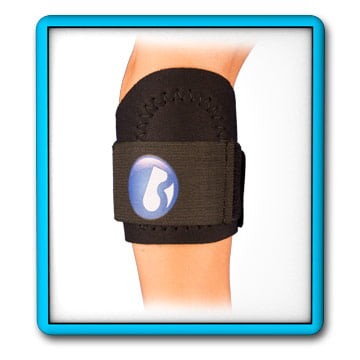Tennis Elbow Article

Tennis Elbow
Tennis elbow is a painful condition that occurs when tendons in your elbow are overworked, usually by repetitive motions of the wrist and arm. Tennis elbow can result from poor technique in executing a tennis backhand. However, many occupations also feature repetitive wrist and arm motions that can cause tennis elbow.
The pain of tennis elbow occurs primarily where the tendons of your forearm muscles attach to the bony prominence on the outside of your elbow. Pain can also spread into your forearm and wrist.
Rest and over-the-counter pain relievers often help relieve tennis elbow. If conservative treatments don't help or if symptoms are disabling, your doctor may suggest surgery.
Product Solutions
Consider the following products to address Tennis Elbow - AE3, AE4 and AE5.
Symptoms
The pain associated with tennis elbow may radiate from the outside of your elbow into your forearm and wrist. Pain and weakness may make it difficult to:
- Hold sports equipment like a hockey stick or tennis racket
- Shake hands
- Turn a doorknob
- Hold a coffee cup
When to see a doctor
Talk to your doctor if self-care steps such as rest, ice and use of over-the-counter pain relievers don't ease your elbow pain and tenderness.
Causes
Tennis elbow (lateral epicondylitis) is an overuse and muscle strain injury. The cause is repeated contraction of the forearm muscles that you use to straighten and raise your hand and wrist. The repeated motions and stress to the tissue may result in inflammation or a series of tiny tears in the tendons that attach the forearm muscles to the bony prominence at the outside of your elbow (lateral epicondyle).
As the name suggests, playing tennis — especially repeated use of the backhand stroke with poor technique — is one possible cause of tennis elbow. However, many other common arm motions can cause tennis elbow, including:
- Using plumbing tools
- Painting
- Driving screws
- Cutting up cooking ingredients, particularly meat
- Excessive computer mouse use
Risk Factors
Factors that may increase your risk of tennis elbow include:
- Age. While tennis elbow affects people of all ages, it's most common in adults between the ages of 30 and 50.
- Occupation. People who have jobs that involve repetitive motions of the wrist and arm are more likely to develop tennis elbow. Examples include plumbers, painters, carpenters, butchers and cooks.
- Certain sports. Participating in racket sports increases your risk of tennis elbow, especially if you employ poor stroke technique.
Complications
Left untreated, tennis elbow can result in chronic pain — especially when lifting or gripping objects. Using your arm too strenuously before your elbow has healed can make the problem worse.
References
- Regan WD, et al. Lateral epicondylitis (tennis elbow). In: DeLee JC, et al. DeLee and Drez's Orthopaedic Sports Medicine. 3rd ed. Philadelphia, Pa.: Saunders Elsevier; 2009. http://www.mdconsult.com/book/player/book.do?method=display&type=bookPage&decorator=header&eid=4-u1.0-B978-1-4160-3143-7..00019-1--sc2&displayedEid=4-u1.0-B978-1-4160-3143-7..00019-1--s0145&uniq=213936826&isbn=978-1-4160-3143-7&sid=1037052489. Accessed Aug. 10, 2010.
- Jayanthi N. Epicondylitis (tennis and golf elbow). http://www.uptodate.com/home/index.html. Accessed Aug. 10, 2010.
- Miller RH, et al. Lateral epicondylitis. In: Canale ST, et al. Campbell's Operative Orthopaedics. 11th ed. Philadelphia, Pa.: Mosby Elsevier; 2007. http://www.mdconsult.com/das/book/body/214290188-3/1038084588/1584/342.html#4-u1.0-B978-0-323-03329-9..50047-7--cesec53_2420. Accessed Aug. 12, 2010.
- Tennis elbow (lateral epicondylitis). American Academy of Orthopaedic Surgeons. http://orthoinfo.aaos.org/topic.cfm?topic=A00068. Accessed Aug. 10, 2010
- Neurological diagnostic tests and procedures. National Institute of Neurological Disorders and Stroke. http://www.ninds.nih.gov/disorders/misc/diagnostic_tests.htm. Accessed Aug. 12, 2010.
- This information provided by The Mayo Clinic with all rights reserved.
